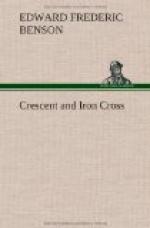[Footnote 1: Lately (September 1917), when the massacres were all over, Talaat, speaking at a Congress of the Committee of Union and Progress, upheld as right and proper the treatment of the Armenian race.]
The race thus marked out for extermination was one of the oldest settlements in Asiatic Turkey. Originally it was confined to Armenia proper, a highland district comprising part of what is now the Russian province of Trans-Caucasia, part of Persia, notably the province of Adarbaijan, and, within the Turkish frontier, the province of Armenia, itself. According to legend, which may well be correct, the Armenians were the oldest national Christian Church in the world, with a liturgy that dates from the first century of the Christian Era, while their translation of the Bible dates from the early years of the fifth century A.D. Here in these uplands they formed a compact and homogeneous population, spread over towns and country alike, and were occupied in the main with agrarian and pastoral pursuits. But they had in addition much of the versatility and business capacity of the Jews, as well as a strong liberal-mindedness towards progress and education, and thus, while they still continued up to the present day their pastoral life in the countryside, others gravitated towards towns, and by degrees they spread over a large part of the Turkish Empire, until most of the towns in Turkey had a progressive and peaceful quota of Armenian citizens, tolerated by their Moslem neighbours, and, though possessed of no great share of political influence, powerful, in that the trade and commerce of inland Turkey was largely in their hands. Wherever they went they established their schools; many were lawyers, doctors, and professors of education. Certain repressive measures were brought to bear on them; they were not, for instance, allowed to carry arms, except when, in accordance with Turkish conscriptive laws, they served in the Ottoman army. But many of them, by paying their exemption money, got off military service, and they confined themselves to the arts of peace, whether pastorally in their native highlands, or in the shops and offices of the towns to which they migrated. They were not, till the time of Abdul Hamid, held to be in any sense a national danger, for, except in Armenia proper, they were too scattered and too peace-loving an element of the population to be capable of united action, and never do they seem to have provoked any outburst of Moslem fanaticism. They had local quarrels and fights with the more warlike Kurds who encroached on Armenia, and in the towns where they settled they often incurred the vague jealousy and dislike which are the penalties of a race superior morally and intellectually to those among whom they live. But that superiority constituted in course of time the ‘Armenian question,’ to which Abdul Hamid alluded. In all, some sixty years ago their entire race numbered about 4,000,000 persons, of whom about 1,250,000 inhabited Russian Trans-Caucasia,




